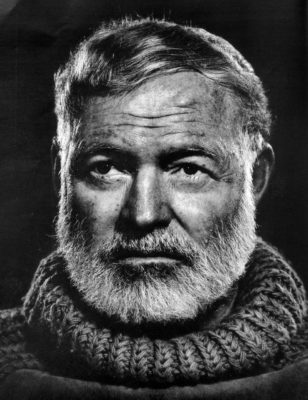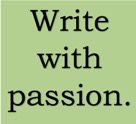
In writing, voice might be defined as the personality, authenticity, sincerity, energy, texture of the narrative. Voice lifts the story off the page and grabs the reader.
Voice consists of the sum of the author’s conscious and unconscious thoughts, perspectives, attitudes and experiential wisdom. It is the skillful way the author delivers his or her truth through the choice and manipulation of language.
Ernest Hemingway’s writing jumps off the page and shouts: “This is Ernest Hemingway!”
“There had been a little rain, the day before, though not enough to flood the lick, which was simply an opening in the trees with a patch of earth worn into deep circles and grooved at the edge with hollows where the animals had licked the dirt for salt, and we had seen long, heart-shaped, fresh tracks of four greater kudu bulls that had been on the salt the night before, as well as many newly pressed tracks of lesser kudu.” (The Green Hills of Africa, p. 6)
Phewww! What a long sentence. Members of a critique group might slash the sentence in two, edit the fat, cut the verbs-to-be, the use of passive and past perfect tense. But here is a Master. He breaks rules and it works. Read the above narrative out loud and hear Hemingway’s “voice.” What makes the piece masterful? Listen to its rhythm, cadence, movement, imagery, word choice, concrete detail, description.

Many of us recognize great writers by their style even before we know who wrote the piece. I recognize the writing of each of the six writers in my critique pod because of their individual voice.
Experience and practice hone one’s authentic and captivating voice. Voice is the accumulation of the skill of the writer, the art of deliverance. Perhaps more than anything else, an author’s voice will hook a reader or an editor.
The writer’s control of language will strengthen the voice, its delivery. Examine how Hemingway’s narrative uses nature as a lurking character, almost like a hunter ready to strike. The voice of this narrative is edgy, nervous, a result of language manipulation.
Here are a few tips to develop an individual voice:
- Practice and practice writing some more. Write without the shoulder editor. Write with passion.
- Learn the rules of writing before breaking them, but please break them eventually.
- Use concrete, specific words: “heart-shaped, fresh tracks of four greater kudu” offers a better visual image than “the tracks of animals.”
- Limit adverbs and write with specific word choice that describes rather than tells: “the kudu limped away from the shotgun” offers more meaning than “the deer walked slowly away from the hunter.” The first example gives the implication that the kudu is injured and how it might have been injured. It also implies what will happen next.
- Active versus passive tense tightens up a read and gives it rhythm and pacing: “where the animals had licked the dirt for salt,” gives the reader an active scene.
- Limit the verbs to be (was, have, to be).
 Meaningful, active verbs paint a picture and a feeling. “Was” lacks meaning and energy. “Limped” offers a picture in one word.
Meaningful, active verbs paint a picture and a feeling. “Was” lacks meaning and energy. “Limped” offers a picture in one word. - Use setting as a character—a backdrop to the story
I know, Hemingway uses “was” and “had” and breaks the rules. He can. He knows how to break them in all the right places. He is a master of language. The reader “sees” and “hears” because of Hemingway’s combination of writing skills, his use of language. Pay attention to developing your unique style through your use of language and its associated elements.
Further reading:
A Clean, Well-Lighted Place, by Ernest Hemingway
The Ones Who Walk Away from Omelas, by Ursula K. Le Guin
Making Shapely Fiction, by Jerome Stern
Writing with Power: Techniques for Mastering the Writing Process, by Peter Elbow

mallory oconnor
Excellent and helpful blog. Thanks.
kaye Linden
I’m glad you enjoyed it, Mallory. Thanks for letting us know. kaye
Susie H. Baxter
Great tips! And for those who want more, check out Linden’s book, 35 Tips for Writing a Brilliant Flash Story. The tips can be applied to ALL writing, not just flash.